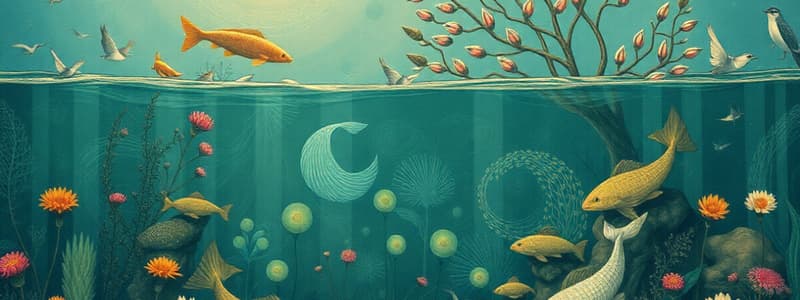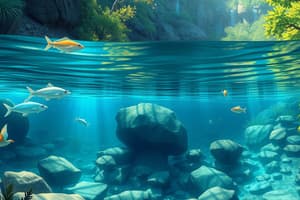Podcast
Questions and Answers
What is a source of dissolved oxygen (DO) in the ocean?
What is a source of dissolved oxygen (DO) in the ocean?
- Chemical reactions in sediments
- Photosynthesis by aquatic plants (correct)
- Increased temperature of water
- Evaporation of seawater
What are characteristics of aquatic biomes commonly studied?
What are characteristics of aquatic biomes commonly studied?
- Urban development and pollution
- Groundwater depletion and soil erosion
- Temperature and salinity (correct)
- Wind patterns and ocean currents
Which steps are involved in the water cycle?
Which steps are involved in the water cycle?
- Runoff, storage, evaporation
- Condensation, precipitation, evaporation (correct)
- Infiltration, transpiration, absorption
- Evaporation, filtration, precipitation
What is an example of point pollution?
What is an example of point pollution?
What are the effects of fertilizer pollution on aquatic ecosystems?
What are the effects of fertilizer pollution on aquatic ecosystems?
Which factor contributes to ocean warming?
Which factor contributes to ocean warming?
What is a consequence of coral bleaching?
What is a consequence of coral bleaching?
What are the steps of wastewater treatment?
What are the steps of wastewater treatment?
Flashcards
Source of DO in ocean
Source of DO in ocean
Dissolved oxygen (DO) in the ocean comes from the atmosphere, photosynthesis by marine plants, and mixing with water from other sources.
Aquatic biomes
Aquatic biomes
Different types of aquatic environments (like lakes, rivers, and oceans) with unique characteristics, influencing organisms living within them.
Water cycle steps
Water cycle steps
The continuous movement of water through evaporation, condensation, precipitation, and collection.
Water withdrawal graph interpretation
Water withdrawal graph interpretation
Signup and view all the flashcards
Point vs. Nonpoint Pollution Examples
Point vs. Nonpoint Pollution Examples
Signup and view all the flashcards
Macronutrient testing reason
Macronutrient testing reason
Signup and view all the flashcards
Effects of fertilizer pollution
Effects of fertilizer pollution
Signup and view all the flashcards
Oxygen sag curve interpretation
Oxygen sag curve interpretation
Signup and view all the flashcards
Eutrophication results
Eutrophication results
Signup and view all the flashcards
Causes of change in DO
Causes of change in DO
Signup and view all the flashcards
Wastewater treatment steps
Wastewater treatment steps
Signup and view all the flashcards
Ocean warming causes
Ocean warming causes
Signup and view all the flashcards
Coral bleaching results
Coral bleaching results
Signup and view all the flashcards
Ocean acidification results
Ocean acidification results
Signup and view all the flashcards
DO calculation (nomograph)
DO calculation (nomograph)
Signup and view all the flashcards
Flood protection
Flood protection
Signup and view all the flashcards
Wetland destruction results
Wetland destruction results
Signup and view all the flashcards



